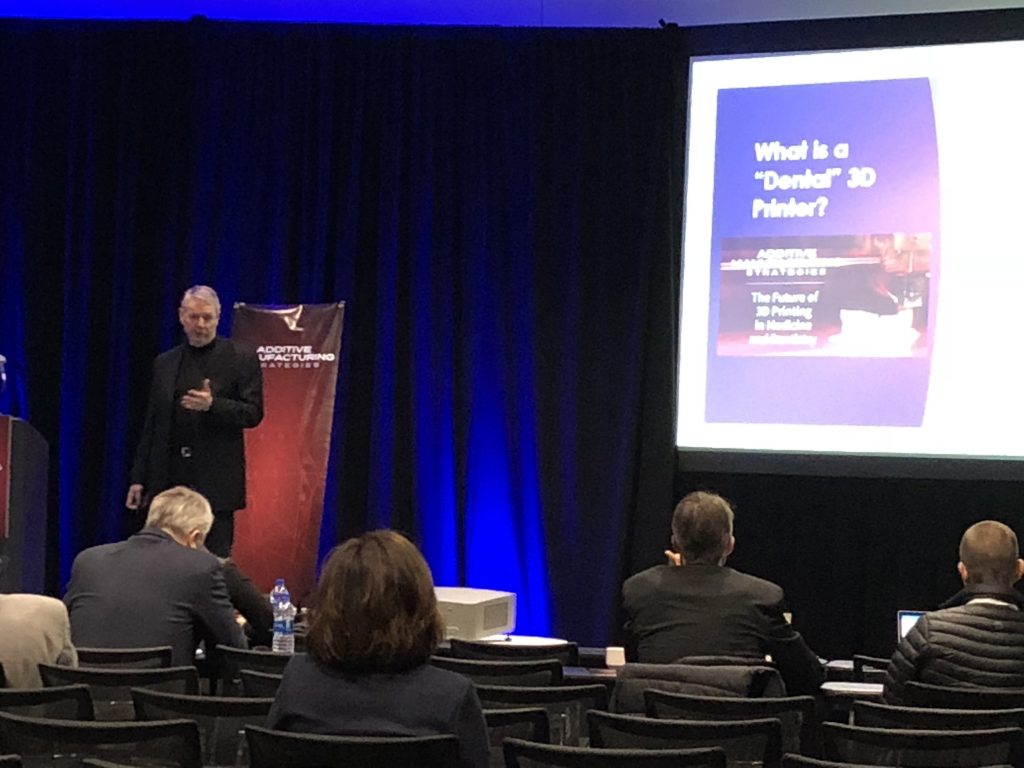After touting it for months, it’s finally here – Additive Manufacturing Strategies, the summit that 3DPrint.com is co-hosting with SmarTech Markets Publishing, has begun. This is the second year for the event – last year’s was held in Washington DC, while AMS 2019 is currently taking place at the Hynes Convention Center in chilly Boston, Massachusetts. Having flown in from an equally chilly Ohio for my first trip to Boston, the temperature feels pretty much the same to me.
Medical and dental 3D printing are projected to generate more than $5 billion in revenue by 2021, and experts from both of these fields will be gathering at the summit, along with other attendees who want to learn more about the latest 3D technologies in medicine and dentistry, the best investment and business opportunities in the field, and more.
 This year’s AMS event, formally called The Future of 3D Printing in Medicine and Dentistry: A Business & investment Summit, has branched out from last year’s, with two tracks for both medical and dental 3D printing. Also new this year is a workshop day and a startup competition, which will have five finalists competing tonight for the chance to win a $15,000 cash investment from Asimov Ventures.
This year’s AMS event, formally called The Future of 3D Printing in Medicine and Dentistry: A Business & investment Summit, has branched out from last year’s, with two tracks for both medical and dental 3D printing. Also new this year is a workshop day and a startup competition, which will have five finalists competing tonight for the chance to win a $15,000 cash investment from Asimov Ventures.
While the exhibition floor and majority of the speakers weren’t open the first official day of the summit, it began with two 90-minute workshops, one for each track, with a brief break for coffee and snacks in between.
The first workshop, “Surgical Planning,” was presented by Robert Wesley, 3D Printing Biomedical Engineer at the St. Louis Children’s Hospital, who oversees operations at the medical 3D printing center located next to the hospital at the BJF Institute of Health at Washington University School of Medicine.
This workshop was designed to offer a more in-depth look at what exactly goes into building these types of medical 3D printing programs, departments, and centers from nothing, and attendees came in expecting to learn about the financial, technical, and clinical impacts that 3D printing can have on institutions, as well as the patients.
Wesley discussed a range of topics, such as software and equipment, educational outreach, personnel requirements and regulatory considerations, imaging standards, operational workflow, and common clinical use cases.Speaking of the latter, he mentioned what we’ve heard in the industry so often in regards to 3D printing in the medical field but is important enough to bear repeating: that 3D printed medical models are so much more helpful than the 2D variety when it comes to looking at complex body parts, such as the aorta.
“Everyone is able to wrap their head around a 3D model,” Wesley said.
In terms of software, Wesley has long used the solutions offered by Materialise, which he called “one of the big boys in the segmentation and 3D printing spaces.” Moving on to imaging protocols, he noted a few, such as CT and MRI scans and 3D datasets, and then progressed to the all-important regulatory considerations, such as documenting the process and surveying both patients and physicians in order to achieve quality assurance.
He mentioned Materialise again when he stated that hospitals should seek to use FDA-cleared medical device systems when fabricating things like surgical guides, templates, and models, as the company recently became the first to receive FDA clearance for diagnostic use of its 3D printed anatomical model software.
 After breaking for coffee, industry analyst and IP lawyer John Hornick of SmarTech Publishing, who spoke at last year’s AMS summit, discussed 3D printing in the dental market during his workshop, titled “Dental 3DP: From The Lab to The Dental Office.”
After breaking for coffee, industry analyst and IP lawyer John Hornick of SmarTech Publishing, who spoke at last year’s AMS summit, discussed 3D printing in the dental market during his workshop, titled “Dental 3DP: From The Lab to The Dental Office.”
“I am not a dentist, nor do I play one on TV,” Hornick quipped during his introduction.
“I wear a lot of different hats in the 3D printing world.”
Hornick is the author of the 2015 book 3D Printing Will Rock the World, and also wrote a new SmarTech report, titled “3D Printed Metals: A Patent Landscape Analysis – 2018.” In his AMS workshop, he discussed how 3D printing applications are taking off in the dental industry, both now and in the future, along with major trends, such as bringing 3D printing into the dental office and closer to the patient.
He discussed how companies are now focusing on the use of 3D printing for specific verticals, such as dentistry. 3D printing has been used in the dental field for nearly 20 years, and, as Hornick stated, “can do almost everything that dental needs.”
Dental 3D printers, Hornick said, are referred to as such because they are typically bundled with dental materials, software, and full solutions. But, 3D printers that are not specifically marketed for dentistry can be used for it, while the so-called dental 3D printers can be used for other applications.
Hornick said that 3D printing users in the industry include labs and clinics, the latter of which includes a solo variety as well as a corporate one. While corporate clinics are made up of consolidated groups of dentists who will band together in order to be able to pay up to $25,000 for a really nice 3D printer, solo clinics are smaller, and won’t typically go much above $5,000…meaning the pressure is on to lower the cost of these systems in order to get closer to patients.
Some of the current applications for dental 3D printing that Hornick listed include:
- Molds for aligner forming tools
- Castable patterns, i.e. bridges and crowns
- Copings
- Models
- Orthodontic and sleep apnea devices
- Surgical guides
- Try-on trays
Moving on to emerging applications in dentistry, which he hilariously noted as being “on the cuspid of this technology,” Hornick mentioned that 3D printed implants, dentures, and other components are on their way.
Stay tuned to 3DPrint.com this week as we bring you more medical and dental 3D printing news from our second annual AMS Summit, which continues in Boston until Thursday, January 31st.
Discuss this and other 3D printing topics at 3DPrintBoard.com or share your thoughts below.
[Images: Sarah Saunders, unless otherwise noted]
Subscribe to Our Email Newsletter
Stay up-to-date on all the latest news from the 3D printing industry and receive information and offers from third party vendors.
Print Services
Upload your 3D Models and get them printed quickly and efficiently.
You May Also Like
Havaianas Collaborates with Zellerfeld to Launch 3D Printed Flip-Flops
The shoe of the summer is undoubtedly the flip-flop. Easy on, easy off, your feet won’t get sweaty because there’s not much material, and they’re available in a veritable rainbow...
UCLA Researchers Develop 3D Printed Pen that May Help Detect Parkinson’s Disease
Diagnosing Parkinson’s disease is difficult. Often, early symptoms of the progressive neurological condition may be overlooked, or mistaken for signs of aging. Early diagnosis can help save lives and improve...
Printing Money Episode 30: Q1 2025 Public 3D Printing Earnings Review with Troy Jensen, Cantor Fitzgerald
Printing Money is back with Episode 30, and it’s that quarterly time, so we are happy and thankful to welcome back Troy Jensen (Managing Director, Cantor Fitzgerald) to review the...
Heating Up: 3D Systems’ Scott Green Discusses 3D Printing’s Potential in the Data Center Industry
The relentless rise of NVIDIA, the steadily increasing pledges of major private and public investments in national infrastructure projects around the world, and the general cultural obsession with AI have...





































